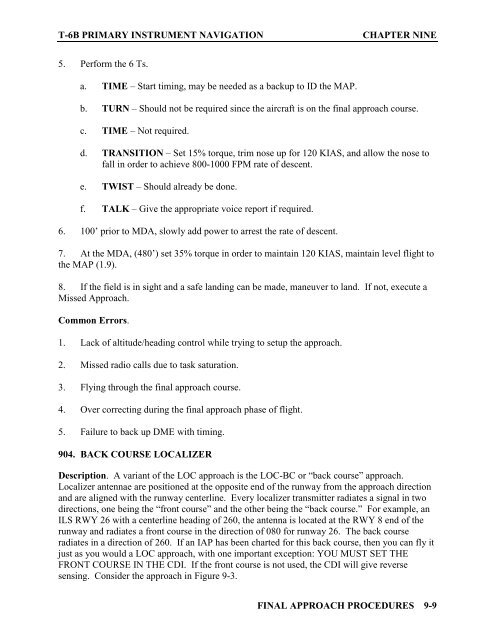Flight Training Instruction - Cnatra - U.S. Navy
Flight Training Instruction - Cnatra - U.S. Navy
Flight Training Instruction - Cnatra - U.S. Navy
You also want an ePaper? Increase the reach of your titles
YUMPU automatically turns print PDFs into web optimized ePapers that Google loves.
T-6B PRIMARY INSTRUMENT NAVIGATION CHAPTER NINE<br />
5. Perform the 6 Ts.<br />
a. TIME – Start timing, may be needed as a backup to ID the MAP.<br />
b. TURN – Should not be required since the aircraft is on the final approach course.<br />
c. TIME – Not required.<br />
d. TRANSITION – Set 15% torque, trim nose up for 120 KIAS, and allow the nose to<br />
fall in order to achieve 800-1000 FPM rate of descent.<br />
e. TWIST – Should already be done.<br />
f. TALK – Give the appropriate voice report if required.<br />
6. 100’ prior to MDA, slowly add power to arrest the rate of descent.<br />
7. At the MDA, (480’) set 35% torque in order to maintain 120 KIAS, maintain level flight to<br />
the MAP (1.9).<br />
8. If the field is in sight and a safe landing can be made, maneuver to land. If not, execute a<br />
Missed Approach.<br />
Common Errors.<br />
1. Lack of altitude/heading control while trying to setup the approach.<br />
2. Missed radio calls due to task saturation.<br />
3. Flying through the final approach course.<br />
4. Over correcting during the final approach phase of flight.<br />
5. Failure to back up DME with timing.<br />
904. BACK COURSE LOCALIZER<br />
Description. A variant of the LOC approach is the LOC-BC or “back course” approach.<br />
Localizer antennae are positioned at the opposite end of the runway from the approach direction<br />
and are aligned with the runway centerline. Every localizer transmitter radiates a signal in two<br />
directions, one being the “front course” and the other being the “back course.” For example, an<br />
ILS RWY 26 with a centerline heading of 260, the antenna is located at the RWY 8 end of the<br />
runway and radiates a front course in the direction of 080 for runway 26. The back course<br />
radiates in a direction of 260. If an IAP has been charted for this back course, then you can fly it<br />
just as you would a LOC approach, with one important exception: YOU MUST SET THE<br />
FRONT COURSE IN THE CDI. If the front course is not used, the CDI will give reverse<br />
sensing. Consider the approach in Figure 9-3.<br />
FINAL APPROACH PROCEDURES 9-9
















